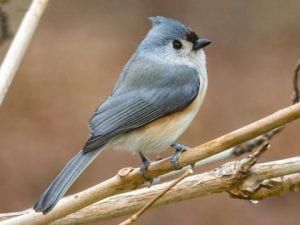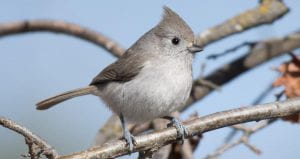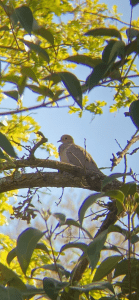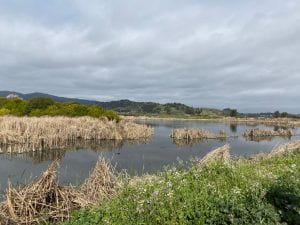Locations: 1637 Menlo Ave, Arcade US-CA (38.5948,-121.3499) (26 m)
Site Description: I went birding in my backyard in Sacramento, California. There are various trees and shrubs in my backyard. Some trees are pretty tall while others are medium sized and the branches came down to just above eye level so some birds could be seen. I heard lots of chirping and bird sounds, but I found it hard to get a visual on all of the birds — just because the trees branches were so dense and it was hard to find the source of the sound. I walked around the backyard and also was looking around the trees in my neighbor’s yards. My neighbor has a very open grassy area in his yard and I saw a few swallows flying around over the grass. They also landed in a tree in my yard, after which I was able to identify it as a tree swallow. The area overall is flat and quiet overall. I did not see any birds on the ground level or in the lower bushes. Most were in the tree branches or they quickly flew overhead. I saw around 5 taxa and the key bird species seen included: American Crow, Oak Titmouse, Tree Swallow, swallow sp., Black Phoebe, and Yellow-Rumped Warbler.
Species Account: Oak Titmouse was a key new species I saw while I was birding. These birds were seen in the small trees. They were very quick but when they stopped they were noted to have a gray head and a white underbody. Its feathers on its head were shaped like a mohawk on its head. It made a high pitch chirping sound that was very distinctive, and matched the one on the Sibley guide. According to the Sibley Guide, these birds are an overall drab gray color on the head and wings with a white underside. They are known to be found in oak trees, although they also live in areas of open pine or other species of trees (All About Birds). Oak Titmouse belong to the order Passeriformes and the family Paridae (Wikipedia). Oak Titmouse flit between branches and fly with shallow undulating flight (All About Birds). Their diet mainly includes insects, nuts, and seeds (Audubon). Oak Titmouse choose their mates for life (Audubon). Females lay 6-7 eggs in each brood and the young leave the nest about 16-24 days after hatching (Audubon).
Narrative:
I went birding for about an hour in my backyard. I started birding around 3 pm and the weather was very nice. The sun was out and there was no wind or overcast. It was a very clear day. I mainly was looking in the branches for any movement and that is where I saw the majority of the birds. There was a couple times when I saw something move but it turned out to be squirrel. I did not see many soaring birds. I only saw a couple of swallows flying overhead/close to the ground very quickly. The birds that I saw in my neighbor’s yard that flew close to the ground very quickly I identified as swallows based on their flight, but I was unsure of their exact species because they were so quick. But I did identify a couple tree swallows when they landed in the tree. I also spotted a couple birds on the fence in the yard. Usually the birds would only sit on the fence for a few seconds before flying away. The Mourning Doves were one of the first ones I noticed. They were pretty big compared to the other birds (other than the crow I saw). The Mourning Dove had speckled spotting on its wing area. The Yellow-Rumped Warbler was a unique find for me because I did not see it at first because it was so blended in the branches. But I saw the bright yellow coloration stand out near its neck, and the black and white striations on its back. The Oak Titmouse was seen with a few others. They had a distinctive mohawk of feathers on their head, which helped me identify them. The Sibley App also allowed me to confirm the ID using the recordings. I saw one Black Pheobe when it landed on the fence. I was able to identify it by its gradient going to black to gray from head to tail. I was happy to see a familiar bird in Sacramento that we first saw in SF. Overall, I was happy with this trip because although I did not see a large number of birds. I did not think that I would see many birds during this time in my own backyard but I was surprised to see some of the ones I did!
Additional Photos or Media: https://ebird.org/checklist/S65992835













